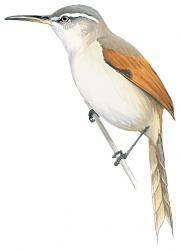Family Furnariidae Tribe Synallaxini Phylum Chordata Order Passerine | Class Aves Subfamily Furnariinae Scientific name Limnoctites rectirostris Rank Species | |
 | ||
Genus LimnoctitesHellmayr, 1925 Similar Curve‑billed reedhaunter, Little thornbird, Hudson's canastero, Patagonian canastero, Freckle‑breasted thornbird | ||
Straight billed reedhaunter limnoctites rectirostris uruguay dc 2014
The straight-billed reedhaunter (Limnoctites rectirostris) is a South American bird species in the family Furnariidae. It is today placed in the monotypic genus Limnoctites.
Contents
- Straight billed reedhaunter limnoctites rectirostris uruguay dc 2014
- Pajonalera pico recto limnoctites rectirostris straight billed reedhaunter
- Taxonomy
- Behaviour
- Distribution and habitat
- Status and conservation
- References
Pajonalera pico recto limnoctites rectirostris straight billed reedhaunter
Taxonomy
Formerly it was – and in some works it still is – placed in Limnornis with the curve-billed reedhaunter (Limnornis curvirostris) which lives in the same general region and habitat, and thus shares some adaptations with L. rectirostris. But L. rectirostris seems closer to the typical spinetails (Cranioleuca) than to the curve-billed reedhaunter. The modern treatment thus makes Limnornis monotypic also. As using monotypic genera if not really necessary is eschewed by most taxonomists today, the straight-billed reedhaunter is liable to be placed in Cranioleuca if further studies verify its placement.
Behaviour
As with many of its relatives, rather little is known about its reproductive habits. In the south of Uruguay, a juvenile was observed in mid-January (i.e. midsummer).
Distribution and habitat
This bird is found in north-eastern Argentina, south-eastern Brazil and Uruguay. In its range it is essentially limited to marshy areas in the pampas and planalto grasslands. In Brazil, it is found in Rio Grande do Sul and Santa Catarina States. In Argentina, it occurs in Entre Ríos and the extreme north-east of Buenos Aires Provinces. In Uruguay, it is limited to the erastern and southern part of the country. In recent years, it has been recorded in Cerro Largo, Canelones, Maldonado – where Charles Darwin recorded it in 1833 at Laguna José Ignacio and Laguna del Diario, where it can still be found –, Rocha, San José and Treinta y Tres Departments (especially at the Quebrada de los Cuervos). From Lavalleja Department, there are only records from 1994, but the bird probably is still found there.
This species prefers marshy and swampy localities between sea level and 1,100 m ASL, and also occurs in more wooded habitat if suitable wetlands are nearby. A key feature of prime habitat is an abundant growth of caraguata (spiny eryngos, Eryngium spp.), such as E. pandanifolium which it utilizes particularly in upland localities. It is sometimes claimed that the two reedhaunters differ in microhabitat preference, occurring sympatrically in the same region but not within the same locality, but this seems to be incorrect.
Status and conservation
The straight-billed reedhaunter may be common in suitable habitat, but globally its numbers are decreasing and is becoming rare due to habitat loss. Significant threats are pollution and the draining of wetlands, particularly for construction on the outskirts of larger towns. Invasive willows (Salix spp.) as well as plantations of eucalypt (Eucalyptus spp.) and pine (Pinus spp.) are also detrimental to habitat quality. The species occurs in some protected areas, such as Área Protegida Quebrada de los Cuervos in Uruguay's Treinta y Tres Department.
